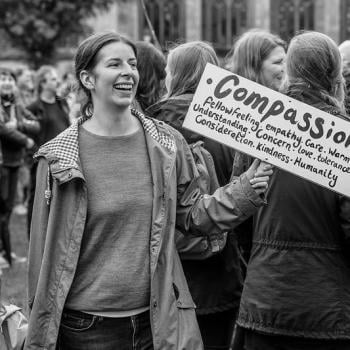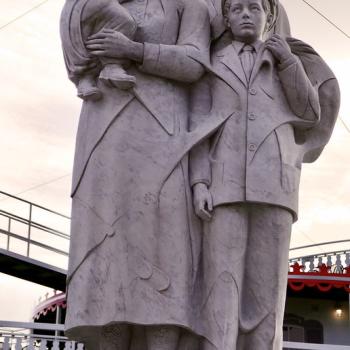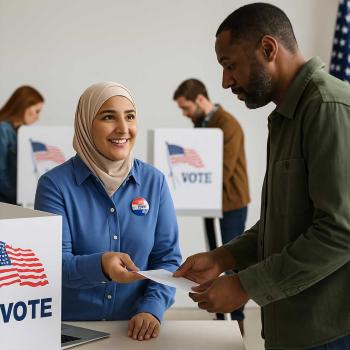The new immigrants who came as adults in the 1960s with preformed identities and a distinctive worldview are in the process of negotiating their identity in a hostile American environment. Increasingly, their children are reshaping them into Americans. For the children, America is the only homeland they know. They often repeat, "I want my parents' religion but not their culture." The parents, on the other hand, have been teaching their Arab culture as Islam, and they want to keep their children within the tradition. It is too early to guess where this process will lead, especially in light of American hostility to nonprivatized Islam. Increasingly, Americans are asking them to define themselves vis-à-vis America. What does it mean to them to be an American? Do they want to be American or hyphenated-American? Do they think of themselves as Muslims living in America? Do they think of themselves as American Muslims? Or do they think of themselves as Americans who happen to be Muslim? While the answers to such questions may vary, there is no doubt that the American public, the American security apparatus, and the American government are increasingly demanding clear and unequivocal answers. In the process, many young people who grew up identifying themselves as American and Muslim are increasingly experiencing relentless prejudice and discrimination. Tempered by prevalent hatred and "othering," many are reidentifying themselves as Arab-American or Muslim-American. As one woman put it, "I feel American, I bleed American, my country denies me that identity because I am a Muslim."
For more resources and conversation on Becoming American?, visit the Patheos Book Club.
[i] In re Dow, 213 Fed. 355, 357 (District Court, E.D. South Carolina, 1914), as cited by Moore, Al-Mughtaribun, 53; Khalil A. Bishara, Origin of the Modern Syrian, cited in Michael Suleiman, "Early Arab-Americans: The Search for Identity," in Crossing the Waters: Arabic-Speaking Immigrants to the United States before 1940, ed. Eric J. Hooglund (Washington, D.C.: Smithsonian Institution Press, 1987), 44.
[ii] Helen Hatab Samhan, "Politics and Exclusion: The Arab American Experience," Journal of Palestine Studies 16, no. 2 (1987): 14.
[iii] Samhan, "Politics and Exclusion," 11-28.
[iv] Samhan, "Politics and Exclusion," 16.
[v] Amy K. Goott and Steven J. Rosen, eds., The Campaign to Discredit Israel (Washington, D.C.: American Israel Public Affairs Committee, 1983), 3-12.
[vi] Fischbach, "Government Pressures," 89.
[vii] New York Times, May 25, 1973.
[viii] Samhan, "Politics and Exclusion," 26.
[ix] Areas designated as the Arab world by the State Department include the Middle East and North Africa.
[x] Hamid Mowlana, George Gerbner, and Herbert I. Schiller, eds., Triumph of the Image: The Media's War in the Persian Gulf-A Global Perspective (Boulder, Colo.: Westview Press, 1992); Nicholas Berry, Foreign Policy and the Press: An Analysis of the New York Times' Coverage of U.S. Foreign Policy (New York: Greenwood Press, 1990); Kenneth I. Vaux, Ethics and the Gulf War: Religion, Rhetoric, and Righteousness (Boulder, Colo.: Westview Press, 1992).
[xi] Reeva S. Simon, The Middle East in Crime Fiction: Mysteries, Spy Novels, and Thrillers from 1916 to the 1980s (New York: Lilian Barber Press, 1989); Albert Hourani, Western Attitudes towards Islam (Southampton: Southampton University Press, 1974).
[xii] Linda Street, Veils and Daggers: A Century of National Geographic's Representation of the Arab World (Philadelphia: Temple University Press, 2000); Edmund Ghareeb, Split Vision: The Portrayal of Arabs in the American Media (Washington, D.C.: American-Arab Affairs Council, 1983); Janice J. Terry, Mistaken Identity: Arab Stereotypes in Popular Writing (Washington, D.C.: Arab-American Affairs Council, 1985).
[xiii] Jack G. Shaheen, Arab and Muslim Stereotyping in American Popular Culture (Washington, D.C.: Center for Muslim Christian Understanding, 1997); Shaheen, Reel Bad Arabs: How Hollywood Vilifies a People (New York: Olive Branch Press, 2001); Shaheen, The TV Arab (Bowling Green, Ohio: Popular Press, 1984).




